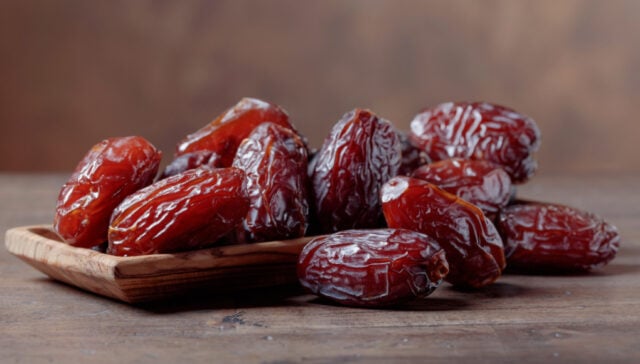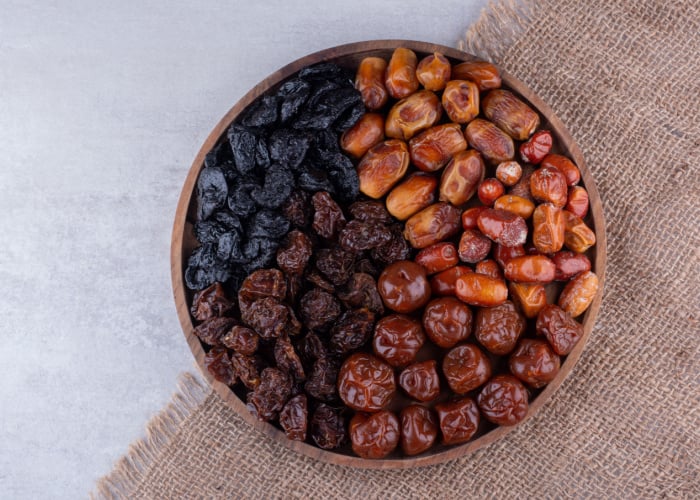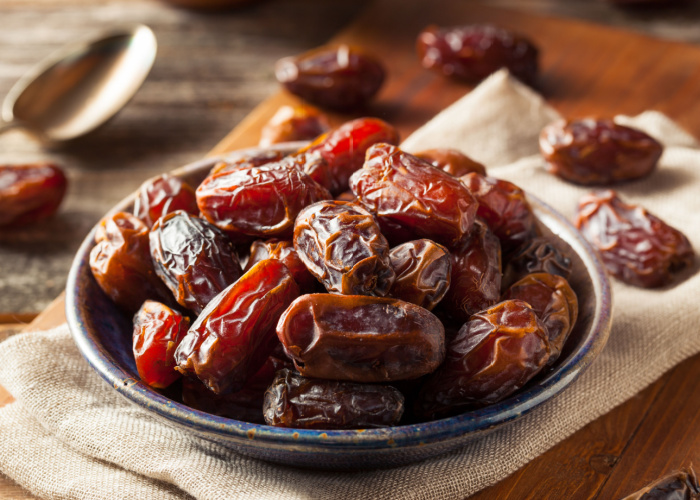
Table of Contents
Food has this seemingly magical effect on dogs.
Especially during training sessions, you can just credit the role food has in motivating them.
And those sweet treats?
Oh, you can just look at how your pup’s eyes light up at the sight of it.
And speaking of sweets…
Can dogs eat dates, you ask?
Or are dates poisonous to dogs?
Well, seems like you need to read this article, then.
But it pays to take note of this reminder by experts of PetMD:
“…understanding how each nutrient is used in a dog’s body, understanding the processes, and knowing how much of each nutrient is needed for a healthy dog at all life stages is very complex.”
Whether dates are good for dogs or not, I’m taking this discussion to a different route.
That means I’ll share with you the real score between fresh and dried dates.
By the way, refer to this guide to quickly navigate through the page:
- 7 Nutritional benefits of fresh dates for your dogs
- 4 Potential risks of dogs eating dried dates
- Other FAQs

Can dogs eat dates?
Dogs can eat dates. It contains vitamins and minerals that are essential for your dog’s health.
However, do not feed lots of dates to your dog simply because it’s not their main diet.
Feed as occasional treats only.
Can Dogs Eat Dates: 7 Nutrients Found in Fresh Dates
Note: All nutrient profile measurements of Medjool dates (per 100-g serving) are taken from the FoodData Central of the US Department of Agriculture (USDA).
Still, we encourage you to always seek your vet for a proper diet and health assessment of your dogs.
1. Fiber
This nutrient profile helps keep your dog’s gut environment stable.
Although minimal in amount, the 6.7 g dietary fiber in Medjool dates (the most popular type) can help supplement your dog’s diet.
Note: Not all fibers are created equal, though.
That’s because there are actually 2 types of dietary fiber that your dog needs, namely:
Soluble
Also known as digestible, this fiber is broken down into molecules upon digestion, which the gut bacteria process into nutrients for your dog’s body to absorb.
Insoluble
Or known as the indigestible kind, this fiber cannot be digested and stays intact as it moves along with food through your dog’s gut.
Insoluble fiber helps your dog’s gut healthy by reducing inflammation and cleaning the mucous membranes.
Great news: Medjool dates mostly contain insoluble fiber.
How much fiber should my dog consume?
In dry dog foods, crude fiber (mostly insoluble) content ranges between 2-4%.
But, you can also follow the 10% rule for fiber-rich supplemental foods for your dogs, such as:
- Apple
- Pumpkin
- Beet pulp
- Brown rice
- Green beans
- Sweet potato
- Flaxseed meal
You can give small slices of fresh dates to your pups as occasional treats, too.
2. Magnesium
Magnesium supports mitochondrial function, normal cardiac rhythm, and provides other benefits.
According to a study, this nutrient plays a vital role in energy production in cells in your dog’s body.
Simply put, the mitochondria help turn the food your pups eat into energy.
And yes, they’re essential for your dog’s survival. How?
This organelle helps decide which cells are dead and should be destroyed.
Containing at least 54 mg of magnesium, Medjool dates are known to have the following benefits for canine health:
- Cell responses
- Normal heart rhythm
- Metabolic processes
- Muscle contraction and relaxation
- Bone mineralization (conversion of organic matter to mineral nutrients)
3. Zinc, Copper & Manganese
Besides tissue functions, fresh dates are found to be beneficial to the reproductive health of your dogs.
That’s because this fruit contains the following trace minerals:
- 0.44 mg of zinc
- 0.362 mg of copper
- 0.296 mg of manganese
What’s more, a study supports that chelated (chemically combined with amino acids) zinc, copper, and manganese leads to higher litter production and survival in female dogs.
These minerals help in the early formation and life of the embryo resulting in fewer deaths.
4. Vitamin B6
Dates contain 0.249 mg of vitamin B6 that’s responsible for the central nervous system functions in canines.
“How does vitamin B6 help improve my dog’s brain functions?”
Well, your dog wouldn’t be able to respond in its environment if not because of the neurotransmitters or the chemical messengers in its body.
And while this contributes to your pup’s alertness, vitamin B6 also harmonizes dopamine and serotonin, or the feel-good brain chemicals.
Thus, improving your pup’s mood.
Not just that, other benefits of vitamin B6 in dogs also include the following:
- Gene activation
- Glucose generation
- Hormone regulation
- Red blood cell production
- Protein, fat, and carbohydrate metabolism
Important: Vitamin B6 deficiency in dogs causes irritability and depression, too.
5. Vitamin A
Containing at least 149 IU of vitamin A, dogs eating dates can enjoy the following benefits:
- Bone growth
- Reproduction
- Cell and immune function
According to a study, vitamin A supplements boost puppy growth from weaning until 1 year of age, suggesting further that:
“…(100 000 IU vitamin A)/4184 kJ (1000 kcal) is a suitable safe upper limit for use in the formulation of diets designed for puppy growth.”
Meanwhile, the main components found in fresh dates are lutein and zeaxanthin, or the pigments that help your pup’s eyes healthy.
That being said, 23 µg of these eye-friendly antioxidants give your Fidos the following health benefits:
- Prevents eye strain
- Eye damage prevention
- Boosts vision and response
- Oxidative stress (imbalance of free radicals and antioxidants) prevention
Fact: Dogs also suffer from retinal loss and damage, especially seniors.
But, a study confirms that eye supplements (i.e. antioxidants) help improve canine eye functions.
6. Folate
Containing 15 µg of folate, dogs eating dates can have a low risk of developing cancer.
Not just that, folate (folic acid) also is found to reduce the occurrence of palate and lip cleft in Pugs and Chihuahua puppies.
7. Iron
Medjool dates contain 0.09 mg of iron, which does wonders for your dog’s health.
According to a study:
The most important function [of iron] is oxygen transport in hemoglobin.
Fact: Iron deficiency in dogs is commonly caused by severe blood loss and decreasing iron reserves in the body.
These are the results of a lack of iron in canine diets.
Meanwhile, the dietary iron requirement for adult dogs is around 80mg/kg.
And for puppies and nursing animals, a higher concentration of iron is needed for their rapid growth since canine milk contains low iron.
Besides iron supplements, you can find this nutrient in meat products, fruits, and vegetables.

Can Dogs Eat Dates: 4 Potential Risks to Dogs Eating Dried Dates
Of course, your dog needs nutrients for optimal health.
But when consumed in excess, the seemingly harmless numbers you can see in the table below can cause more harm than good to your pups.
| Nutrient Profile | Fresh Dates (per 100 g) | Dried Dates (per 100 g) |
| Carbohydrates | 54.9 g | 80.6 g |
| Protein | 1.50 g | 2.14 g |
| Fat | 0.14 g | 0.38 g |
Not only that, but you’ll need to pay attention to the sugar content in dried dates, too. (More on that in a bit.)
So, when you feel like generously rewarding your furballs with dried treats today, please don’t.
Science says there are a ton of reasons why. Let me summarize it for you.
1. High in Fats
A study claims that high-fat diets can easily cause obesity in dogs.
“…feeding a high-fat diet is associated with insulin resistance, reduced brain insulin transport, decreased microbiota α-diversity, and reduced abundance of Prevotella, Solobacterium, and Coprobacillus.”
When your dogs consume high-fat food like dried dates, the list of health complications includes the following:
Hyperlipidemia
Did you know: The most important fats in your dog's body are cholesterol and triglycerides.
For healthy dogs, fat levels go back to normal a few hours after eating.
But in the case of hyperlipidemia, the opposite is true.
Hyperlipidemia is characterized by too many fat molecules (lipids) in the bloodstream.
While underlying health conditions (i.e. sugar diabetes, liver, and kidney disease) directly trigger hyperlipidemia in dogs, high-fat foods are also contributing factors.
So, watch out for the following symptoms if you suspect hyperlipidemia in your dogs:
- Vomiting
- Diarrhea
- Seizures
- Lack of appetite
- Abdominal discomfort
- Skin problems (hair loss or itching)
- Cloudy, milky discharge due to inflammation in one or both eyes
- Lipid deposits in certain tissues of the body (skin, eyes, and blood vessels)
Important: Hyperlipidemia may not necessarily show signs in your dog’s body unless other health condition arises.
If you’re constantly feeding high-fat foods like dried dates to your dogs, they’ll likely develop heart issues.
So, watch out for the following conditions:
- Chest pain or pressure
- Blockage of blood vessels in the brain and heart
To prevent this life-threatening case, your dogs need a low-fat, high-fiber diet along with enough exercise.
Pancreatitis
This medical condition is characterized by inflammation of the pancreas.
Your dog’s pancreas produces enzymes to assist in food digestion and hormones such as insulin, which regulates blood sugar or glucose metabolism.
Note: Glucose metabolism is the process of converting simple sugar to energy.
If you suspect your pooch is suffering from pancreatitis, watch out for the following symptoms:
- Fever
- Nausea
- Vomiting
- Diarrhea
- Lethargy
- Abdominal pain
- Decreased appetite
Without the pancreas, your dog will rely on diabetes treatment throughout its lifetime.
So, to help prevent your dogs from pancreatitis, avoid feeding them large amounts of high-fat foods like dried dates.
Note: This disease is directly related to obesity and diabetes in dogs, too.
Intestinal Dysbiosis
Speaking of diabetes, dogs suffering from one are found to have a bacterial imbalance or intestinal dysbiosis.
A study found that fat contributes to “changes of gut microbial community structure” in canines.
High-fat diets also play a big role in the overgrowth of pathogens or bad bacteria in your dog’s gut.
And overgrowth of pathogens can cause metabolic disorders and inflammatory bowel disease in your dogs leading to the following symptoms:
- Diarrhea
- Vomiting
- Weight loss
- Decreased appetite
As a form of prevention, you’ll need a more holistic approach for your beloved pups, which are the following:
- Prebiotics and/or probiotics
- Switch to a low-fat, high-fiber diet
2. High in Carbohydrates
Did you know: Feeding inappropriate amounts of carbs to your dogs can make the cancer cells healthy while weakening your pup.
Dr. Carol Osborne, DVM, of Chagrin Falls Veterinary Center & Pet Clinic says that cancer mainly benefits from oxygen and carbohydrates BUT:
“…while we can’t adjust the oxygen, we can adjust the carbs.”
According to VCA Animal Hospitals, “…dogs with cancer should eat a nutrient profile with no more than 25% carbohydrate on a dry matter (DM) basis.”
Note: There’s no universal diet that suits all dogs with cancer.
However, dogs with cancer often have difficulty in carbohydrate metabolism.
Or the process that ensures a constant supply of energy to your pup’s living cells.
Some dogs may not be suitable for grain-rich foods; some may need oats and other whole grains.
Important: Your vet must be the first person you seek advice from regarding this matter.

3. Too Much Protein
Proteins are the building blocks of your dog’s health, but too much can be a bad thing, too.
So, if your dog keeps feasting on dried dates, it’ll likely develop or experience the following conditions:
Weight Gain and Obesity
According to Ashley Gallagher, DVM:
“With over 50% of dogs in the U.S. considered overweight or obese, dog owners need to be aware of where those extra calories are hiding.”
Fact: Unhealthy weight gain in dogs poses health risks.
You might have been feeding them the wrong diet.
And since dried dates are high in proteins — known to be calorie-dense — you can just imagine the unhealthy nutrient level your dog is taking in its system.
Unfortunately, obesity in dogs can trigger a lot of diseases, such as:
- Arthritis
- Cancer
- Diabetes
- Heart failure
- Liver disease
- High blood pressure
- Chronic kidney disease
- Bladder or urinary tract disease
- Low thyroid hormone production
Important: If your dog has an underlying medical condition, be sure to seek expert advice for proper diet assessment.
Liver and Kidney Damage
If your dog has liver or kidney problems, too much protein in its system can put unnecessary stress on these organs.
Unhealthy protein levels in the canine diet can also cause nutrient imbalance, which worsens your dog’s condition.
Without proper intervention, dogs with liver disease can suffer from seizures and coma.
Or worse, death.
In severe conditions, this liver disorder can lead to a brain condition called hepatic encephalopathy.
Kidney disease, on the other hand, can also pose life-threatening risks to your dogs leading to:
- Lethargy
- Loss of appetite
- Toxin (i.e. nitrogen and ammonia) buildup in the body
Feeding dogs with kidney disease can be tricky. So, be sure to check this with your vet.
RELATED: How to Feed Dogs With Liver Disease
4. High in Sugar
So, what does that table below translate to your dog’s health?
Well, sugar isn’t sugar if not because of its 3 main components — sucrose, fructose, and glucose.
As you can see, the levels of the main components of sugar in dates increase due to the drying process that reduces the fruit’s moisture.
| Sugar | Fresh Dates (per 100 g) | Dried Dates (per 100 g) |
| Sucrose | 4.03 g | 11.6 g |
| Fructose | 19.4 g | 29.4 g |
| Glucose | 22.8 g | 30.4 g |
While these 3 things all taste sweet, they actually have different roles in your pup’s body.
Glucose
To begin with, glucose is the ideal type of sugar that supplies energy to your dog’s body.
This component is called the building block of carbohydrates, too.
When absorbed through the intestines and into the bloodstream, glucose spikes your dog’s blood sugar levels quickly; stimulating the release of insulin.
Fructose
Just like glucose, fructose is also directly absorbed in your dog’s bloodstream through the intestines.
This component can spike your pup’s blood sugar levels but only gradually.
However, eating large amounts of fructose — especially on a high-calorie diet — can raise blood triglyceride levels in your dogs.
Note: Triglyceride is a type of lipid (fat) that circulates in your dog’s blood.
Excessive fructose intake can also increase the risk of metabolic syndrome (which causes obesity) and nonalcoholic fatty liver disease.
This is due to too much absorption of fructose in your pup’s body which promotes an increased creation of fat stores in the liver.
Remember: Fructose is sweeter than glucose, which makes commercial foods tastier but poses higher health risks.
Sucrose
Simply put, sucrose is the scientific name for table sugar.
This component is a naturally occurring carb found in many fruits, vegetables, and grains.
It’s also added to many commercial foods, such as:
- Soda
- Candy
- Ice cream
- Canned foods
- Breakfast cereals
- Other sweetened beverages.
Sucrose is partially broken down into glucose and fructose through the enzyme in your dog’s mouth.
While sucrose further splits into glucose and fructose in the intestines, the presence of glucose increases the amount of fructose in the bloodstream.
The result?
Your dog’s body works double time creating more fat stores in the liver.
Key Takeaway
Dogs with diabetes and other similar conditions are not advised to eat fruits that are high in sugar like dried dates.

Can Dogs Eat Dates: FAQs
What part of the date fruit should dogs eat?
Dogs should eat the fleshy part of dates and not the seed (containing the kernel and pit).
The pits of dates are potential choking hazards to your dogs. So, avoid it.
How many dates can dogs eat?
Dogs can eat 1-2 pieces of dates occasionally and no more.
That’s because dates are not part of your dog’s ideal diet.
Besides that, dates are high in sugar which can cause serious health risks in the long run, if given in excess.
If unsure, seek your vet’s advice for a proper assessment of what your dogs should eat.

Can Dogs Eat Dates: Before You Go…
Dates are safe for your dogs to eat.
But it’s best to be aware of the possible threats if your dogs eat too much of this sweet fruit, right?
As a pet guardian, that’s your role.
And at Top Dog Tips, it’s our job to help you “become a better dog owner.”
Found this blog helpful?
Take a look at our top related picks below!












